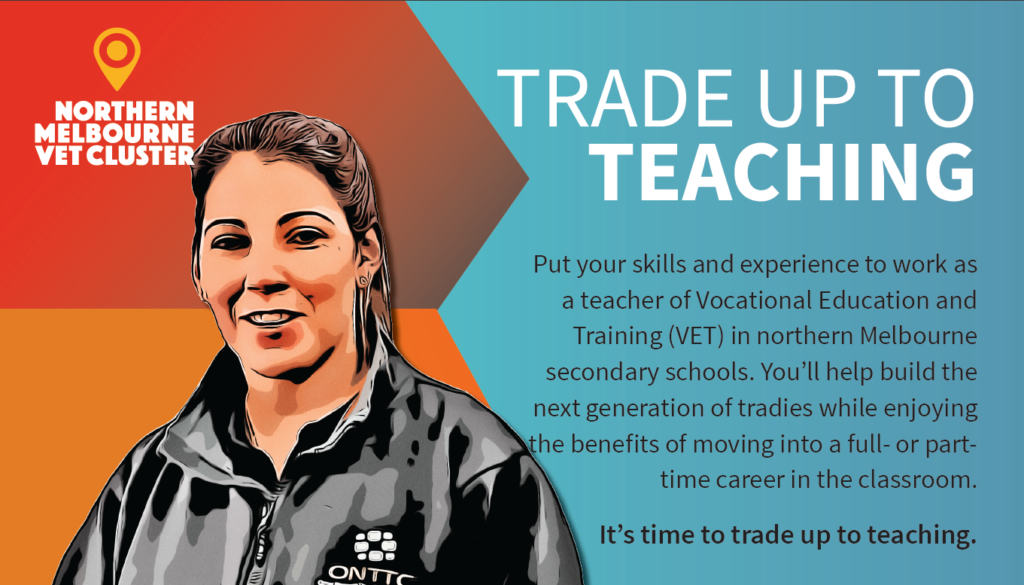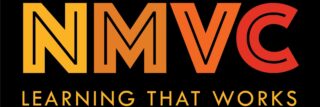
Become a VET Teacher
Put your skills and experience to work as a teacher of Vocational Education and Training (VET) in northern Melbourne secondary schools. You’ll help build the next generation of tradies while enjoying the benefits of moving into a full- or part-time career in the classroom.
It’s time to trade up to teaching.
Background
The Need for VET Teachers
As a tradesperson, you’ll be aware that there is a significant shortage of skilled, trained people in the trades, which has a significant impact on Australia’s economic prosperity and business success.
At present it’s difficult to identify, train and retain apprentices, who are the lifeblood of industry. The solution is to train more young people to pick up a trade in skills shortage areas, and that starts in secondary schools where Vocational Education and Training (VET) is offered to students. VET refers to enhanced senior school studies, which enables a secondary student to combine their VCE with vocational training. To facilitate this training in secondary schools we need more tradies to trade up to teaching.
About You
If you’re a tradesperson looking to trade up to teaching you should have the following attributes, skills and experience:
Personal Attributes
- You like working with young people
- You are passionate about your trade’s area and want to impart that passion and the relevant skills to young people
- You are patient, flexible and adaptable
- You are open to learning and feedback
- You are a good team player
Transferable Skills
- You are friendly, with good people skills
- You have strong knowledge and high quality skills in your area of trade’s expertise
- You have high level organisational skills
- You have the ability to engage and motivate others
- You can engage well with younger people and build a supportive team environment
Experience
- You need to have completed an apprenticeship (in traditional trades where apprenticeships are a traditional pathway) plus have five years experience in industry
- In trades without apprenticeship pathways, you must have more than five years industry experience in the relevant learning area
- You do not need to be a member of a trade association but you do need to be highly competent in your trade
Watch
What is VET?
- Vocational Education and Training (VET) is an accredited vocational education and training program (usually completed over two years).
- It enables students to complete a nationally recognised vocational qualification (e.g. Certificate III in Building and Construction) and a senior secondary certificate such as VCE at the same time.
- It allows students to go directly into employment or receive credit towards further study.
- It focuses on students developing industry specific and workplace skills.
- It is a vocationally oriented school program designed to meet the needs of industry.
The Job
Training and teaching young people is a rewarding career. Teaching VET in secondary schools offers flexibility, longevity and rewards not usually available to tradespeople ‘on the tools’. In addition, if you’ve perhaps been injured in the workplace, you might find that teaching in purpose-built training facilities like those at many NMVC schools will enable you to get back to work safely.
Here are the key benefits of teaching that many VET teachers say they like the most:
Benefits
- Working in a supportive team environment
- Having school holidays off which can be great if you have school aged children
- Starting salary is often well above the starting salary for first year teachers
- Can opt to teach part-time and continue with one’s business/work for the other days
- Seeing young people really grow and succeed
- Job security as we need more ongoing teachers/trainers in the system
What You Could Teach
To meet student demand and identified industry shortfalls, skilled and experienced people are needed to teach the following learning areas:
Arts and Media – You could teach courses such as: Applied Fashion Design & Technology; Creative Industries; Dance; Music Industry (Performance & Sound Production Streams; Screen & Media (Games Development, Video & Screen Streams); Visual Arts
Business – You could teach Business
Community Services, Health and Education – You could teach courses such as: Allied Health Assistance; Community Services; Early Childhood Education & Care; Health Services Assistance
Electrical Trades – You could teach courses such as: Electrotechnology; Integrated Technologies
Engineering and Science – You could teach courses such as: Engineering Studies; Laboratory Skills
Hospitality – You could teach courses such as: Hospitality; Cookery
Mechanical Trades – You could teach Automotive Vocational Preparation
Primary Industries – You could teach courses such as: Agriculture; Horticulture; Permaculture
Retails and Personal Services – You could teach courses such as: Beauty Services; Make Up; Salon Assistant
Sport and Recreation – You could teach courses such as: Sport & Recreation; Sports Coaching
Trades – You could teach courses such as: Building & Construction (including Bricklaying, Carpentry, Wall & Floor Tiling); Construction Pathways; Furniture Making Pathways; Musical Instrument Making and Maintenance; Plumbing.
Becoming a Teacher
You need a TAE Certificate IV in Training & Assessment to teach in a school. This, together with the required industry qualifications and experience (an apprenticeship plus five years in industry) would allow you to apply for positions in schools. Employer schools would then assist you in getting Permission to Teach registration with the Victorian Institute of Teaching, which will allow you to teach in your subject area at the school. Note: Assistance may be available with payment for the TAE Course.
To Learn More
Step 1. Watch the video above to hear from VET teachers working in NMVC member schools.
Step 2. If you’d like to learn more please fill out the confidential Expression of Interest form below.
Step 3. We’ll be in touch to talk about what’s next. This might include a phone call, school visit or invitation to an information session.
Note: The EOI is NOT a job application form. VET teachers in secondary schools are employed by schools, rather than the Northern Melbourne VET Cluster. Expressing your interest in becoming a VET teacher is a step on the career transition path that may lead you to the classroom.
Act Now!
There’s never been a better time to trade up to teaching. Complete the Expression of Interest Form below and we look forward to supporting you in your transition to a challenging and rewarding career in the education sector.
